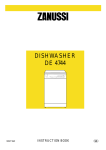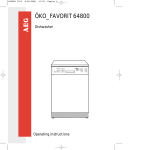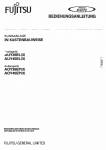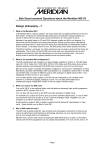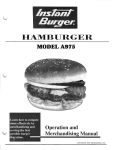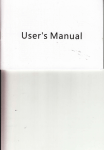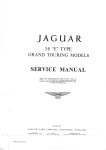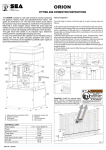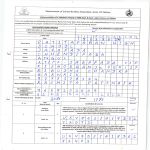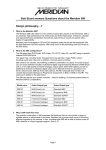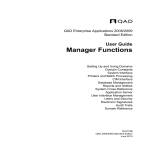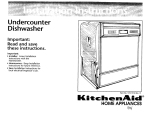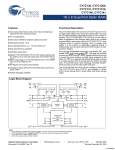Download Service Manual
Transcript
Description of Models This service manual is written for models BB, BC, and
qeD series. There are two models for each series.
r example, in the BB series, there are models BB71
d BB73. The only difference between the two Is the
phase. On all models, the model designated '71" is a
single phase unit and the model designated ,3" is a 3
phase unit.
intermediate size pot and has six (6) clamp down knobs
on top. It has an inside pot diameter of 14 SIS" 1.0.
The BCD is the largest size. The BCD model is basi
cally a double BC or two BC units put together in a single
cabinet. Although there is a single power source on
the BCD model, the controls mounted behind the pres
sure pot operate that particular pot. This means that
each set of controls for each pot operates Independently
of each other. This gives fleXIbility in loading and tim
ing. It also means you won't be out of the barbecue
business if one side happens to malfunction. The other
side still should work Independently of that side.
As far as service and repairs are concerned, all the mod
els have the same circuitry, and operate the same.
Therefore, the service will be substantially the same on
all three models. The only difference in the models are
Size and wattage. These difference will be pointed out
in the service manual.
All models can be changed in the field to either 20S
VAC or 240 VAC. If the voltage is not specified when
ordered, the unit will be wired for 208 VAC at the fac
tory. It may be changed to 240 VAC by disconnecting
the top element. A single phase unit may be changed
to 3 phase with a change of cord and relay. This may
be ordered as a modiflcatlon kit (see page 24).
The BB unit is the smallest model. It is easily identifi
able as having only four (4) clamp down knobs on top.
It has an inside pot diameter of 13 5IS". The BC is an
BB
BC
BCD
Description of Operation Before heat is applied, the ejector or pressure relief valve
should be placed in the closed (horizontal) position. The
drain valve should also be closed. It is not necessary or
desirable to release the air within the cooker.
The heat is applied when the timer is set. This causes
the unit to build pressure. The wood then chars and
creates smoke, which being under pressure, is forced
all through the food.
The initial pressure begins at 0 psi and builds to 15 psi.
Then the pressure may vary between 10 psi and 15 psi
as heat Is automatically applied and removed. The pres
sure and temperature are automatically regulated. A
pressure solenoid valve will release a small amount of
steam should the pressure start to build over 15 psi.
The ejector or pressure relief valve is open when the
stem is erected in a vertical position and closed when it
is in a horizontal position. There is a safety pressure
relief valve which will release the pressure if it exceeds
16 to 17 psi.
At the end of the cooking cycle, the pressure will be
automatically released. When the pressure gauge in
dicates zero pressure, the ejector valve should be
placed in the vertical (open) position to insure complete
exhaust. The cooker may be opened and the cooked
food may then be removed.
The Smokaroma barbequer combines the modem sci
entific method of pressure baking with pressure smok
ing to get that "old-fashion- hickory smoke flavor. It
does this economically, automatically. and in a fraction
of the time to prepare barbeQue by ordinary methods.
In operation as a barbequer, a small amount of hickory
is placed in the smoke generator cup. Meats or foods
to be cooked are prepared according to the recipes and
then either placed in racks which stack one on top of
the other, food basket. or hung from spits on the meat
rack. The capacity of each rack or food basket shelf is
approximately Sibs. of meat. The meat rack spits will
accommodate approximately 30 to 45 Ibs. of meat. Af
ter the cooker is loaded with the desired amounts of
food to be cooked, the lid Is placed thereon such that
the two "L· shaped slots are aligned with their respec
tive clamp bolts and knobs. The two knobs are rotated
-...ward in the slots to the upright position. Then the
.J is rotated clockwise until It stops. The remaining
Clamp bolts (2 on the BB and 4 on the BC and BCD)
may then be rotated upward In the slots and tightened.
Tighten opposite knobs at the same time until all are
snug.
-1
SmokaromaPreventive Maintenance Suggestions DAILY
1. At the end of each day, completely clean inte
rior of the Bar-B-Q Boss. Do not fill with water
above bottom of smoke generator. You only
need to pour 1 quart of water on the bottom.
Add detergent (such as "Dawn" soap). Scour
good with a Scotch Brite maroon pad. Drain
water and dry thoroughly. It is not necessary
to scour a/l the smoke stain off the cooker. It is
only necessary to scour grease and burnt crust
of food off the walls, bottom and underside of
top.
2. Clean meat rack or food basket in sink.
3. Wipe underside of lid, O-ring, and cooker pot
ring with a damp dish cloth to clean of dirt and
debris.
"CLEANLINESS
IS
90%
OF
WEEKLY
1. After cleaning machine, squeeze soap solution
through top port hole until it runs out port hole
in cooker.
2. Flush cooker exhaust system by placing 2
quarts of water into cooker. (Add 1/4 cup soap
solution. "Dawn" is excellent.) Run up to pres
sure and allow cooker to "pop off' for 25 min
utes.
3. Turn off cooker and exhaust pressure. Remove
water and dry cooker.
4. Lubricate knobs and bolt threads, underside
of knobs, and top of lid where knobs turn.
MAINTENANCE"
MONTHLY
1. Observe pressure cut off point. Green light
should "cut off" at 12 psi. If not, see service
manual (page 22) for adjustment.
2. Observe pressure exhaust point. Exhaust
should occur at between 14 to 15 psI. If not,
see service manual (page 22) for adjustment.
COPPER FILTER
'CH~
BOY'
PT. NO. 1790
3. Observe timer cut off point. Dial should point
to "Zero" at cut off point. If not, remove dial knob
and adjust.
4. Observe gauge to see if it remains in calibra
tion, especially after abuse (for example, see if
the gauge leaks, or if the dial is bent, etc.). If
not in calibration, replace the gauge.
Figure 1
5. Tighten any loose nuts, bolts, or screws.
There is a copper "Chore Boy" filter located Inside
the exhaust port. The exhaust port is located on
the left inside of the cooker, just to the left of the
charring element housing, if looking from the front
of the machine. The purpose of this filter Is to pre
vent food particles from entering your exhaust sys
tem and clogging the lines. You should not oper
ate the machine without the filter in place. Change
the filter according to No.9 of "Monthly Mainte
nance Suggestions".
6. If ejector valve leaks, replace it.
1. Do not tamper with safety valve. If it leaks, re
place it.
8. Examine units for any broken, missing, or de- .
teriorated parts. Replace immediately; do no\..
operate in a defective condition.
9. Change "Chore Boy" filter at least once per
month and more often with heavy usage.
-2
Controls & Functions 6. Green Neon Indicator Ught (Pressure) Indicates voltage is applied through pressure switch to heating elements. Should go out at 12 psi. Green light will not light in "Cold Smoke" mode. 7. White Neon Indicator Light (Cold Smoke) Indicates when "Cold Smoke" switch is in the "Cold Smoke" mode. 8. Ejector Valve Provides manual valve for closing to build pres
sure and opening to relieve pressure. 9. Safety Valve Provides valve for relieving pressure should it ex
ceed 17 psi. Resets at 15 psi. . Figure 2
1. TImer Switch Provides timed on-off main switch. All lights should come on when first turned on if thermostat is in "Bar B-O" position. 10. Pressure Gauge Indicates pressure (psi). After initial pressure is built up, it normally operates between 12 .and 15 psi (indicated by green area). 2. Red Neon Indicator Light (Power) Indicates timer switch Is on and power is being ap
plied to machine. 11. Drain Pan Use In cleaning cooker. It Is located beneath the cooker directly beneath the drain valve. Pan catches drippings out of cooker pot when opening drain valve.
.
3. Thermostat
'ovides automatic "Hold" control. Provides over
eat prevention control. When set at IIBar S.a·
position. thermostat will cut out .at a bottom tem
perature of 5500 F. When this happens. both the
temperature neon light (amber) and the green neon
light will go off, or if in "Cold Smoke" mode the
amber and white light will go off. When the tem
perature drops below 550 0 F, the thermostat will
automatically cut back on.
12. Charring Cup Container which holds wood for charring during the smoking process. 13. Charring Element Provides heat source of 230 watts at 240 volts for charring wood. 4. Amber Neon Indicator Light (Temperature)
Indicated voltage is being applied through thermo
stat to heating elements.
14. Lid Rack Used to hold the top lid when not in use. It is lo
cated on side of cooker cabinet. 5. "Cold Smoke" Switch
Provides "Cold Smoke"- "Hot Smoke" mode. In
the "Qtr or down position, the unit is in the "Cold
Smoke· mode; only the Charring Element will heat.
The white neon light will come on (with amber and
red) when the timer is set to "On" and the thermo
stat is set to Bar-S-O.
15. Muffler Designed to condense some moisture being re
leased from the machine and prevent splattering on the wall. 16. Drain Valve and Handle Provides for cleaning when opened. Should be closed during the cooking operation. Valve is opened when handle is rotated counterclockwise to the down or vertical position. In the "On" or up position, the unit is in the "Hot
Smoke" mode. The main elements will provide
"eat along with the Charring Element. The green
jon light will be on (with amber and red) when
->the timer is set to "On" and the thermostat is set to
Bar-B-O. However, the green light will cycle off
when approximately 12 psi is reached and on when
pressure drops below 10 psi.
17. O-Ring Provides pressure seal when lid is clamped in place. -3
·Controls & Functions Figure 3
at end of cooking cycle and to control pressure
at below 15 psi by exhausting intermittently dur
ing cooking cycle. The exhaust solenoid Is con
trolled by the Timer Switch and Pressure Switch
NO.2.
18. Power Relay Provides power to the main elements when en ergized by control circuit~ The control circuit consists of timer switch. thermostat and Pres
sure Switch No.1, all in series with power relay coil. 21. Terminal Strip (TB-1 thru 5) Provides junction for connecting wires. 19. Main Elements PrOVides main source of heat. Each element is rated at 1540 watts @ 240V for the BS and 1650 watts @ 240V for the Be and BCD. Four (4) elements are used @ 208V. The extra element at the lower voltage (208V) produces about the same wattage as three (3) elements at the higher voltage (240V). Three (3) elements are used @ 240V. 22. Low Side (Left) Pressure Switch (No.1)
Opens control circuit at 12 psi to de-energize
Power Relay thereby removing heat. Closes at
11 psi on pressure drop to energize power relay
the reby adding heat.
23. High Side (Right) Pressure Switch (No.2)
Opens solenoid at approximately 14 1/2 psi to
control pressure at below 15 psi. Closes at ap
proximately 13 1/2 psi on pressure drop.
20. Exhaust Solenoid Provides valve to exhaust steam automatically -4
Quick Check for Functions & Controls The following is a method of performing quick checks on the 8ar:-B-O Boss to see if it is functioning
rrectly. It ma.lnly consists of visual checks and checks by touch. It is divided into three parts: "Function
checks for Indicator Lights ...", "Function checks for Power Relay ..•", and "Function checks for leaks ..."
Be sure all checks are made before going to another part.
1. Function checks for Indicator Lights, Time Switch, Thermostat, Pressure Switch and Solenoid.
A. Action:
1. Plug machine into outlet of proper voltage. (See nameplate).
2. Turn thermostat knob to the "Sar-S-O" position.
3. Rotate timer switch to 1 hour and slowly back to the "0" position.
B. Checks - The following should happen: All indicator lights (except cold smoke light when
cold smoke switch is in the up position) should light and then go off when the pointer on the
time switch reaches "0" time.
C. Possible Troubles - If these things do not happen, it may indicate one or more of the following
troubles:
.
SYMPTOMS a. No indicator lights come on.
b. Power light comes on
but Amber (Temperature)
and Green (PresslJe)
lights do not come on.
POSSIBLE TROUBLES
1. Assuming correct·voltage is
available at the outlet, defective
wiring in power cord.
TO REPAIR SEE:
"I. Won't Heat, 9, Detailed
Trouble Shooting Charf',
page 8 and "Wiring Diagram",
pages 31 , 32, and 33.
2. Defective wiring in control box.
"I. Won't Heat, C, Detailed
Trouble Shooting Chart",
page 8 and "Wiring
Diagram", pages 31,32 and 33.
3. Defective timer switch
"I. Won't Heat, D, Detailed
Trouble Shooting Chart",
page 8 and "How
Replace Timer Switch",
page 20.
4. Defective lights. Exploded Parts Sheet, page 30.
1. Defective wiring.
Wiring diagram pages 31, 32,
and 33.
2. Defective thermostat. "I. Won't Heat, E, Detailed
Trouble Shooting Chart",
page 8.
3. Defective lights Exploded Parts Sheet, page 30.
4. Thermostat must be turned to
8ar-8-Q position. -5
Quick Check for Functions & Controls c. Power and temperature
lights (Red and Amber)
comes on but Green
pressure) light does not
come on.
2. Defective Pressure Switch.
Wiring diagram. pa.ges 31 t 32
and 33.
"I. Won't Heat Detailed
Trouble Shooting Chart",
page 8.
3. Defective Lights.
Exploded Parts Sheet, page 30.
1. Defective wiring.
4. Defective Cold Smoke Switch.
D. Action - Press "Cold Smoke" down to Cold Smoke position. Repeat above A, B, and C.
E. Assuming that all controls function correctly when checked above, a further check should be
made as follows:
II. Function checks for Power Relay, Charring Element, and Main Elements:
A. Actions and Checks: Caution: These checks should only be done when cooker is cold or from a
cold start.
1. Rotate thermostat to the "BAR-B-Q" position and then rotate timer switch to "2" hours on
the dial. All lights should light and solenoid should energize.
2. Immediately remove top and briefly touch the charring rod. It should start to get hot to the
touch in a very short time.
3. Put hands on lower side of cooker to see if it becomes warm when the cooker is cold, it may
take several minutes before the side becomes warm to the touch.
B. Possible Trouble - If these things do not happen it may indicate one or more of the following
problems.
SYMPTOMS e. Charring Element does not
become warm.
.
POSSIBLE TROUBLES
1. Defective wiring.
TO REPAIR SEE:
For all troubles listed here, see
"IV. .Won't Create Smoke,
. Detailed Trouble Shooting
Chart'", page 13.
2. Defective Thermostat.
3. Defective Charring Element
f. Side of cooker does not
warm. 1. Defective wiring.
For all troubles listed here, see
"I. Won't Heat, Detailed Trouble
Shooting Chart", page 8.
2. Defective Power Relay.
3. Defective Main Elements.
4. Cold Smoke Switch must be
in "UP" position and green light
is "on".
·6
(Note: This unit has four
separate elements. Therefore
it's rare that all elements will
burn out at once unless an over
voltage has been applied. Most
likely the wires from the power
relay are defective.
F. Assuming that all controls or parts are functioning correctly to this point, make the following test:
III. Pressure checks for leaks, check for solenoid functioning, calibration checks for pressure switch
and time switch and addition check for maIn element.
'\ I
A. Action:
1. Remove the meat rack assembly or food basket, and charring cup.
2. Put 1 quart of water on the bottom.
3. Rotate thermostat to the "Bar-B-Q" pOSition and then rotate time switch dial to "2" hours.
(Note time on your watch when time switch was set to "2" hours.)
4. Place top on and clamp down with ejector valve in the closed position.
B. Checks - When this is done the following should happen:
1. Pressure should build.
2. The timer switch should move one mark clockwise after 5 minutes.
3. The green light (Pressure) should go out when the pointer of gauge is at 12 psi when pres
sure is rising.
4. The solenoid should exhaust when the pOinter of the gauge is between 14 and 15 psi when
pressure is rising.
C. Possible Troubles - If these things do not happen, it may indicate one or more of the following
problems:
SYMPTOMS
a. Pressure does not start to
rise at all after 15 minutes.
POSSIBLE TROUBLES
1. Leak
2. Defective Gauge
TO REPAIR SEE: .
"III. Heats But Won't Build
Pressure, Detailed Trouble
Shooting Chart", page 12.
3. Defective Ejector, release, or
safety valve
4. Defective Drain Valve
b. Pressure starts to rise
but does not get over 5 psi.
1. See A 1, A2, and A3 above.
"". D. Heats Only Warm,
2. One or more Main Elements
Detailed Trouble Shooting
Chart", page 11.
is defective.
c. Green light will not go out
at 12 psi.
1. Pressure setting is too high
"How to Adjust Pressure
Switch", page 22.
d. Pressure will not release at 141/2 psi.
1. Pressure Switch setting is too
high or low.
"How to Adjust Pressure
Switch", page 22.
2. Defective solenoid
3. Pressure line stopped up.
-7
"VII. Won't Exhaust, Detailed
Trouble Shooting Chart",
page 16.
Detailed Trouble Shooting Chart FOREWORD TO THE "DETAILED TROUBLE SHOOTING CHART LIST"
The Detailed Trouble Shooting Chart list the "Trouble", what to "Check or Adjusf and what further YOlO
need to do to fix it under "For Information See". We tried to list the "Trouble" just as the customer waul
experience or say it. The most prevalent trouble, "Won't Hear is listed first. To repair, find the description
which is mostly closely associated with the problem and proceed step by step down the "Check or Adjust"
list. When the problem is isolated to a part, see the reference listed under "For Further Information See". If
this solves the problem, you may then test the unit according to the "Quick Check" to make sure everything
is functioning correctly. If it is, congratulations, if it is not, proceed to the next step.
Generally the procedure is written for low voltage (208 to 240V AC) and Single phase. Since all control
circuits (208 to 240V AC, single phase) are the same regardless of the voltage or phase, the trouble shoot
ing will be the same for it. Where the procedure differs it will be marked clearly with a phrase "For 3
Phase".
Detailed Trouble Shooting Chart TROUBLE
CHECK OR ADJUST FOR FURTHER
INFORMATION SEE:
1. WON'T HEAT
A. VOLTAGE - (Thermostat should be rotated to
the "SAR-S-O" position). Voltage at outlet
should be same as voltage specified on name
plate ± 5%. If not, have electrician to correct.
Name plate on back of
of cover of 8ar-8-Q Boss.
B. Make sure unit is disconnected from outlet.
Remove back cover, check all wire connections
for loose or burnt connections. Plug into outlet
and measure voltage across terminal R·1 and
R-2 of power relay. Voltage should be the same
as that specified on name plate ± 5%. If not,
check handle cap (plug) to see if it is wired right.
(Green is ground.)
"How to Remove Back Panel", page 20 and "Wiring Diagram" on pages 30, 31, and 32. For 3 phase: Check voltages across terminals
R-1 and R-2, across R-1 and R-3, and across
R-2 and R-3. Voltage should be the same as that
specified by the name plate ± 5%.
C. Check voltage R-1 and TB-S. It should show
208 to 240 VAC ± 5%. If not, replace white wire
from R-2 to TB-5.
"Wiring Diagram· on pages 30, 31, and 32. D. TIMER SWITCH - Check time switch as follows:
1. Turn timer switch to "1" hour position.
2. Connect voltmeter across TB-1 and TB-5 on
terminal strip. Voltmeter should read 208 to
240 VAC ± 5%. If it does, proceed to "En.
. "Wiring Diagram" on
pages 30, 31, and 32.
3. If it does not, check wiring up to this point
"Wiring Diagram" on by removing black wire to timer switch, from
pages 30, 31, and 32. the timer switch terminal. Connect voltmeter
across the end of the black wire and at relay
R-2 terminal. Voltmeter should read 208 to
240 VAC ± 5%. If It does not, replace black wire.
-8
4. Turn timer switch to the "On" position and
measure the voltage from the timer switch
terminal where the orange wire is connected
and TB-S. The voltmeter should read 208 to
240 VAC ± 5%. If it does not, replace the timer
switch. If it does, connect voltmeter across
TB-1 and TB-5 on terminal strip. Voltmeter
should read 208 to 240 V AC ± 5%. If it does
not, replace orange wire. If it does, proceed
to "E" below.
"How to Replace Timer
Switch", on page 20.
E. THERMOSTAT - The thermostat should be in
the "BAR-B-a- position. Check the voltage
between TB-2 and TB-S. The meter should show
208 to 240 VAC ± 5%. If it does not, check the
voltage between the thermostat terminal where
the purple wire connects and TB-5. Voltmeter
should read 208 to 240 VAC ± 5%. If it does not,
replace the purple wire. If 208 to 240 VAC ± 5%
appears, then check and see if It appears between
the thermostat terminal on which the black and
white striped wire is connected and TB-S. If it
does not, replace the thermostat. If 208 to 240
VAC ± 5% appears, then proceed to "P.
"How to Replace
Thermostat", page 21.
See "Wiring Diagram",
pages 30, 31 and 32.
F. PRESSURE SWITCH NO.1 - Check voltage
with voltmeter between Pressure Switch No.1
terminal (left pressure switch) on which the
green wire appears and TB-5. Voltmeter should
read 208 to 240 VAC ± 5%. If it does not, replace
the green wire. If it does, check the voltage
between the Pressure Switch No.1 terminal on
which the blue wire appears and TB-5; 208 to 240
VAC ± 5% showd appear. If it does not, adjust the
pressure switch. If pressure will not adjust, replace
pressure switch. If the voltmeter does read 208
to 240 VAC ± 5% proceed to "Gil below and check.
'Wiring Diagram- on
pages 30, 31 and 32.
"How to Adjust Pressure
Switch", page 22.
"How to Replace Pressure
Switch, page 22.
G. POWER RELAY - Check the voltage with a volt
meter between terminals R-4 and R-5 on the
power relay coil. Voltmeter should read 208 to
240 VAC ± 5%. If it does, and the relay is not
energized, replace the relay. If the voltmeter
does not read 208 to 240 VAC ± S% check the
voltage between R-4 and TB-5. Voltmeter should
read 208 to 240 VAC ± 5%. If it does not, replace
the blue wire to the coil. If it does read 208 to
240 VAC ± 5%, replace the white wire from the
coil to TB-S. If the relay is energized and elements
do not heat, proceed to "H- and check.
"Wiring Diagram- on
pages 30, 31 and 32, and
How to Replace Power
RelaY'. page 23.
H. MAIN ELEMENTS - Remove bottom control panel
cover to expose the element ends. There are
four (4) elements per cooking unit. Three (3) are
used for 240/415 volts operation and four (4) are
used for 208-220/380 volts operation. Check the
voltage between R-6 and R-7 of the power relay
with the relay energized. The voltmeter should
read 208 to 240 VAC ± 5%.
"How to Remove Back
Panel and Bottom Control
Panel Cover". page 20.
-9
Wiring Diagram, pages
30,31 and 32.
Detailed Trouble Shooting Chart For 3 Phase: With the relay energized, check the
voltage between R-6 and R-7, between R-6 and R-a
and between R-7 and R-B. Voltage should be the
same, in each case, as that specified by the name
.
plate ± 5%.
Single Phase Cont.: Check the voltage at the
element terminals where the leads are connected.
The voltmeter should read 20B to 240 VAC ± 5%.
If it does not, check continuity of the lead wires by
connecting one (1) voltmeter lead to R-6 and one (1)
voltmeter lead to the element terminal on the left side.
Voltmeter should read 208 to 240 VAC ± 5%. If it
does not, replace the lead wire on the left side.
Reverse this process by checking the voltage between
terminal R-7 on the power relay and the element
terminal on the right side of the elements. The
voltmeter should read line voltage ± 5%. If it does not,
replace the lead on the right side.
"How to Replace Heating
Element", page 29.
If the voltmeter reads line voltages across the terminal
of the elements and anyone does not heat, remove all
connections on the elements and check the resistance
with ohmmeter of each element. The resistance should
read 35 ohms ± 5% for the BC and BCD and 37 ± 5%
ohms for the BB. If the ohmmeter indicates differently
than these values, replace the element or elements.
For 3 Phase: Check the voltage at the element terminals
where each of the three leads are connected. That is,
check between lead one (1) and lead two (2), lead one (1
and lead three (3), and 'lead two (2) and three (3). In
each case, the voltmeter should read line voltage ± 5%. If
it does not, check continuity of the lead wire by connecting
one voltmeter lead to R-6 and any of the other two
corresponding lead terminal at the element. For example,
if your voltmeter lead is on R-6 then the other lead should
be on the lead terminal end at the element of lead two (2).
The voltmeter should read line voltage. If it does not, re
place lead two (2). Repeat this process for R-7 checking
the voltage at the end of lead 3 at the element terminal.
Also for R-8, checking the voltage at the end of lead
one (1) at the element terminal. You may also check con
tinuity of the lead wires with an ohmmeter. Be sure the unit
is unplugged and voltage is removed. Check the continuity
by measuring between R-6 and the end of the lead in at the
element terminal. If it does not have cont.inuity, replace the
lead. Repeat this process for R-7 and R-8.
It lhe voPbrrem reads line voltage across the terminals of
any of the elementS and any one element does not heat, re
move all connections on the element and check the resis
tance with the ohmmeter of each element. The resistance
should read 35 ohms ± 5% for the Be and the BCD, and
37 ± 5% ohms for the BB. If the ohmmeter indicates differ
ently then these values, replace the element or elements.
-10
Detailed Trouble Shooting Chart n. HEATS ONLY
WARM AND
PRESSURE
BUILDS UP
EXCEEDINGLY
SLOW
CHECK OR ADJUST
FOR FURTHER
INFORMATION SEE:
A. VOLTAGE - Check line voltage and be sure
that the voltage [s same as specified on
nameplate ± 5%. If it Is, check and see if 208
to 240 VAC ± 5% Is applied to the L1 and L2
wires in power coret Green wire should be
grounded. Sometimes with a three wire
power cord, a lower voltage is applied to the
cooker through error. If this Is the case,
correct plug or receptacle such that the
correct voltage is applied, to L1 and L2
wires in power cord.
Wiring Diagram, pages
30, 31 and 32.
For 3 Phase: Une voltage should appear
between l1 and L2, L1 and l3. and L2 and
La.
B. Check amperage with an "Amprobe· type
meter by encircling one lead to main
elements. It should read not less than 20
amperes (See Wiring Diagram page 30 for
actual current on l1 and L2). If it reads
.Iess than 20 amperes, recheck •A" above and then proceed to "C" below. Wiring Diagram. pages
30. 31 and 32.
For 3 phase: this current reading should not
be less than 5 amperes but not more than
11 ampheres. (See WIring Diagrams, pages
31 and 32) for actual current on l1, L2, and L3.
C. MAIN ELEMENTS - With the timer switch
·On" and the thermostat rotated to "Bar-B-a"
position, check voltage at terminals of element.
It should be the same as the 208 to 240 VAC ±
5%. If It Isn't, check through -I. Wontt Heat,
Detailed Trouble Shooting Chart" then correct
defective parts. If the 208 to 240 VAC ± 5%
appears across terminals of main elements
proceed to "H· "I. Won't Heat, Detailed Trouble
Shooting Chart".
-11
"How to Replace Main
Element", page 29.
Detailed Trouble Shooting Chart FOR FURTHER
INFORMATION SEE:
TROUBLE
CHECK OR ADJUST
m. HEATS BUT
A. GAUGE - Check for leaks around gauge
connections. If loose. tighten. Check gauge
to see if pointer is unobstructed. If defective,
replace gauge.
WON'T BUrLD
PRESSURE
B. EJECTOR VALVE - When stem is down. ejector
valve should be closed and pressure tight. If
the ejector valve leaks. replace.
C. SAFETY VALVE - Safety valve should function
at 17 ± 1 psI. It will then reset Itself, at approxi
mately 15 pst. If the safety tends to leak slightly,
sometimes It can be stopped by slight pressure
with your finger. If it continues to leak, replace.
D. SEAL - Check O-ring for cracks or breaks.
Check O-ring and the surface where It seats on
the pot ring. Both should be free of foreign
matter, such as. hickory shavings, prep mix or
sauce. The pot ring should also be free of
nicks and scars.
E. PLUMBING - Check aJl connections and pipe
fitting In panel for leaks. Check manifold
connections on cooker body, and around drain
valve for leaks (preferably with air pressure and
using soap suds). Tighten any loose fittings.
Replace drain valve if it leaks.
F. VOLTAGE AT SOLENOID - Check voltage
across terminal with black wire on right pressure
switch (No.2) and T8-5, 208 to 240 VAC ± 5%
should appear. If it does and solenoid will not
close, replace solenoid. If 208 to 240 VAC ± 5%
does not appear at these terminals with power
on, check "A- through -0- of "I. Won't Heat,
Detailed Trouble Shooting Chart". If this checks
out, then, check voltage between terminal with
black wire on right pressure switch (No.2) and
TB-5, 208 to 240 VAC ± 5% should appear.
If not, check adjustment of right Pressure Switch
(No.2). If pressure switch will not adjust.
replace pressure switch.
-12·
"How to Replace
Solenold-, page 25.
"How to Adjust
Pressure Switch-.
page 22.
"How to Replace
Pressure Switch-,
page 22.
Det ailed Trouble Shooting Chart "P'lOUBLE
CHECK OR ADJUST
IV. WON'T
A. VOLTAGE - With time switch set at "1· hour and
thermostat at "Bar-B-Q" position, check volt
age across TB-2 and TB-S. LIne voltage
should appear. If not, voltage should be
checked as specified In "A" through "E· under
III. Won't Hear trouble.
CREATE
SMOKE
FOR FURTHER
INFORMATION SEE:
B. CHARRING ELEMENT - If 208 to 240 VAC
± 5% appears across T8-2 and T8-5, the
charring element should heat. If it does not,
check for loose terminals. If none are found.
replace charring element. AHemate: Check
the resistance of the charring element with an
ohmmeter. It should read 250 ohms ± 10%.
If it does not, replace the charring element.
'rROUBLE
CHECK OR ADJUST
"How to Replace
Charring Element",
page 21.
FOR FURTHER
INFORMATION SEE:
V.OVERHEATS
A. Check for leaks. If cooker is leaking, It
cannot get up to cutoff pressure (12 psi
for left pressure switch No.1) to open
solenoid and remove heat, and cooker
will overheat.
B. LEFT PRESSURE SWITCH (1) - Pressure
switch should cut off at 12 psI. If It does not,
adjust pressure switch to cut off at this
pressure. If pressure switch will not adjust,
replace.
"How to Adjust Pressure
Switch", page 22.
"How to Replace Pressure
Switch·, page 22.
C. RIGHT PRESSURE SWITCH (2) - Pressure
switch should open.solenold at 14 1/2 psi and
release pressure to approximately 13 112 psi.
If it does not, adjust pressure to open at
141/2 psi. If pressure switch will not adjust,
replace.
"How to Adjust Pressure
Switch", page 22.
D. THERMOSTAT - The thermostat is designed
to prevent overheating, and possible damage
to unit. It Is designed to cut off at a temperature
of 550 0 F at point on which the thermostat bulb
is mounted. Rotate thermostat knob slowly
toward "oW. Thermostat should click off .
somewhere between "hold" and "orr posItion at
approximately the 2:00 o'clock position.
"How to Replace
Thermostar, page 21.
-13
"How to Replace Pressure
Switch", page 22.
Detailed Trouble Shooting Chart TROUBLE
FOR FURTHER
INFORMATION SEE:
CHECK OR ADJUST E. MAIN ELEMENTS - Check element connection
configuration to see if they are wired for the
right voltage. (See bottom of wiring
diagram.) For low voltage (208 to 220/380 volts)
operation. four (4) elements are used. For high
voltage operation (240/415 volts). three (3)
elements are used. If four (4) elements are
used on high voltage operation, the unit will
overheat. Rewire connections. if incorrect.
Rewire Connections
Dlagram-.
pages 31, 32 and 33.
~ring
For Single Phase: Elements are connected in parallel. For 3 Phase: Elements are connected either in a -Delta- or -vlye- configuration. F. POWER RELAY - Power relay should be normally -How to Replace Power
RelaY', page 23. . open when no voltage is applied. You should be
able to move the contactor from the nonnally closed position with your fingers (make sure power Is removed before trying this). If the contacts are welded in the normally closed position. relay should be replaced. If contact points are badly pitted. replace power relay.
.
TROUBLE
CHECK OR ADJUST
VI. PRESSURE
BUILDS UP
HIGH
A. CHECKING PRESSURE LINES AND CONNECTORS
1. Check large exhaust port hole, and adapter
located inside cooker above and to the left of the
charring element cavity. Remove back panel. Be
sure hose and adapter are not stopped up by
disconnecting hose from solenoid and blowing
through hose. If there is any obstruction, replace
hose andlor adapter.
FOR FURTHER
INFORMATION SEE:
2. Remove Muffler and blow .through it to be sure
it is not stopped up. Clean to remove any
obstruction.
3. Check pressure switch port hole located on back
-14
J
Detailed Trouble Shooting Chart of charring element housing. Be sure it is not
stopped up by disconnecting hose from pressure
switches manifold and blowing through hose. If
there is any obstruction, replace hose and/or
adapter.
B. LEFT PRESSURE SWITCH (1) - Observe
pressure Indicated on gauge at which pressure
Indicator light (green) cuts off. This point should
be at 12 pSi. If not, adjust pressure switch
to open at this point If pressure switch will not
adjust, replace.
C. RIGHT PRESSURE SWITCH (2) - Pressure
switch should open solenoid at 14112 psI and
release pressure to approximately 131/2 psI.
If it does not, adjust pressure switch to open at
14112 psI. If pressure switch will not adjust,
replace.
-How to Adjust Pressure
Switch-, page 22.
"How to Replace
Pressure Switch-,
page 22.
-How to Adjust
Pressure Swltch-,
page 22.
"How to Replace
Pressure Switch-,
page 22.
D. POWER RELAY - Power Relay should be
normally open when no voltage Is applied. You
should be able to move the contactor from the
normally closed position with your fingers (make
sure power cord Is removed before trying this).
If the contacts are welded in the normally closed
position, replace relay. If contact points are badly
pitted, replace power relay.
"How to Replace Power
Relay" I page 23.
TROUBL E
CHECK OR ADJUST
FOR FURTHER
INFORMATION SEE:
vn. PRESSURE
A. Tighten Micro-Switch attachment screws on each
CUTOFF
pressure switch.
POINT
VARIES
OR
CHANGES
AFTER
ADJUSTING
B. LEFT PRESSURE SWITCH (1) - Observe
pressure Indicated on gauge at which green
indicator light cuts off. This point should
be at 12 psi. If not, adjust pressure switch
open at this point. If pressure switch will not
adjust, replace.
-15
"How to Adjust Pressure
Switch", page 22.
-How to Replace
Pressure Swltch-,
page 22.
Detailed Trouble Shooting Chart C. RIGHT PRESSURE SWITCH (2) - Pressure
switch should open solenoid at 14 1/2 psi and
release pressure to aproximately 13 1/2 psi.
If it does not, adjust pressure to open at 141/2 psi.
If pressure switch will not adjust, replace.
"How to Adjust
Pressure Switch",
page 22.
"How to Replace
Pressure Switch", page 22.
D. CHECKING PRESSURE LINES AND CONNECTORS
1. Check large exhaust port hole, and adapter
located inside cooker above and to the left of the
charring element cavitiy. Remove back panel.
Be sure hose and adapter are not stopped up by
disconnecting hose from solenoid and blowing
through hose. If there is any obstruction, replace
hose and/or adapter.
2. Remove Muffler and blow through it to be sure it
is not stopped up. Clean to remove any obstruction.
3. Check pressure switch port hole located on back
of charring element housing. Be sure it Is not
stopped up by disconnecting hose from pressure
switches manifold and blowing through hose. If
there is any obstruction, replace hose andlor adapter.
TROUBLE
CHECK OR ADJUST
VllI. WON'T
. EXHAUST
A. Remove muffler and blow through it to be sure it is
FOR FURTHER
INFORMATION SEE:
"How to Reoair Solenoid
not stopped up. Crean it to remove any obstruction. ' ValVe-; page 2'6 or
"How to Replace Solenoid",
page 25.
B. EXHAUST HOSE - Disconnect exhaust hose
from solenoid valve to muffler. Blow through it to
be sure that It Is not obstructed. If it is, remove
obstruction or replace hose.
C. Remove hose from solenoid bottom. Blow
through solenoid to be sure it is not obstructed.
It it is, remove obstruction or replace solenoid.
D. Check large exhaust port hole and adapter located
inside cooker above and to the left of the charring
element cavity. If it is obstructed, remove obstruction or
replace hose and/or adapter.
-16
Detailed Trouble Shooting Chart TROUBLE
CHECK OR ADJ UST
FOR FURTHER
INFORMATION SEE:
IX. PRESSURE
A. Blow though solenoid to be sure it is not obstruct
ed, if it is, repair or replace solenoid valve.
BLEED OFF
TOO SLOW AT
end of cooking
B. Disconnect exhaust hose from bottom of solenoid
exhaust valve. Blow through it to be sure it Is not
cycle. (ThIs
obstructed. If It is, remove obstruction or replace
happens either
hose.
or during cooking
cycle, when
Solenoid opens
C. Disconnect solenoid exhaust hose from side of
to relieve excess
solenoid to muffler. Blow through it to be sure It Is
pressure. Some
not obstructed. If it is, remove obstruction or
replace.
times green light
will also come on.
D. Check large exhaust port hole and adapter located
inside cooker above and to the left of the charring
element. If it is obstructed, remove obstruction or
replace hose and/or adapter.
"How to Repair Solenoid
Valve, page 25 or "How to
Replace SolenOid",
page 26.
TROUBLE
CHECK OR ADJUST
FOR FURTHER
INFORMATION SEE:
x. TIMER SWITCH
A. Plug power cord into outlet with correct voltage.
Rotate timer switch through lOON· poSition and all
the way around clockwise slowly to the ·Zero· time
position. If timer switch is working correctly red
'(power) indicator light will light and then go off at
the ·ZERO· time division: If red light does not come
on, then proceed to ·C· and check.
POINTER WON1T
' MOVE" -,
B. If red light comes on and timer switch Is In
calibration, tum timer switch pointer to "2" hour
position and time with watch. Timer switch
pointer should move one mark clockwise in 5
minutes. If pointer does not move, check to see
if timer switch motor-leads are connected to TB-1
and TB-5. If they are and pointer does not move,
proceed to "C".
C. Check timer switch as follows:
1. Tum timer switch to ·1· hour position. -17
Detailed Trouble Shooti 9 Chart· 2. Connect voltmeter across T8-1 and TB-5 on
terminal strip. Voltmeter should read 208 to
240 VAC ± 5%. If it does replace timer switch.
-How to Replace Timer
Switch·, page 20.
3. If it does not, check wiring up to this point by
removing black wire to time switch, 'from the
time switch terminal. Connect one lead of
voltmeter to the end of the black wire and the
other lead to relay R..2 terminal. Voltmeter
should read 208 to 240 VAC ± 5%. If it does
not, reptace wire. If the voltmeter does read
208 to 240 VAC ± 5% at the end of the terminal,
put the wire back on timer switch terminal.
4. Tum timer switch to the -On- posltion and
-How to Replace TImer
measure the voltage from the timer switch
Switch·, page 20.
terminal where the orange wire Is connected
to and where the other end Is connected to TB·5.
The voltmeter should read 208 to 240 VAC ± 5%.
If It does not, replace the time switch. If it
does, replace the orange wire and repeat -e
above.
TROUBLE
CHECK OR ADJUST
FOR FURTHER
INFORMATION SEE:
XI. CHATT.EBINO
NOISE IN
BACK WHEN
T1MER IS
TURNED ON.
Note: Generally this conditiondescribes" aJow.
voltage or Incorrect voltage application. The most
common which occurs is the application of 120V
on a 240V line. The resulting noise Is caused by
the relay and solenoid trying to -pullin· but can't
because of insufficient voHage (both have 208 to
240V colis). This problem is generally caused by
the plug or receetacle being wired Incorrectly.
~ HQW .to,Be.pJaceCbarrlng
A. VOLTAGE - Check line voltage and be sure
that it is same voltage as that specified on name
plate ± 5%. If It Is, check and see If line voltage
Is applied to the L1 nd L2 wires in power cord.
Green wire should be grounded. Sometimes on
a three wire system. one half voltage (110 to 120
volts) Is applied to the cooker through error. If
this Is the case, correct plug or receptacle such
-18
Elemenf', page 21.
Detailed Trouble Shooting Chart that correct voltage Is applied. to black and
white wires in power cord.
B. Check amperage with an ..Amprobe type
meter by encircling one lead to the main
element. It should read no less than 20
amperes. If it reads less than 20 amperes,
check itA" above. (See wiring diagram for
actual current on L1 and L2).
lt
Wiring Diagram.
pages 30. 31 and 32.
For 3 Phase: This current reading will be ·
less than 5 amperes but not more than 11
amperes (See wiring diagram for actual cur
rent on L 1, L2, and L3.
TROUBLE
CHECK OR ADJUST
FOR FURTHER
INFORMATION SEE:
'ill. TI MER SWITCH
Note: Generally this contion describes a
charring element shorted to the ground.
"How to Replace Charring
Elemenr, page 21.
"OFF"BUT
INDICATOR
LIGHTS ON
DIM AND
RELAY AND
SOLENOID
CHATTER.
In thi.s case. the charring element mayor
may not heat. However, It allows a voltage
(maximum of 120 volts) to be applied across the
lights, power relay and solenoid from the other
side of 240 volts (even though the timer Is off).
The low voltage Is sufficient to alow them to
light dimly and to chatter. but it is not enough to
fully activate them.
A. VOLTAGE - With timer switch in the -On"
position, check voltage from TB-3 to TB-4.
It should read 208 to 240 VAC ± 5%.
B. With timer switch in the -otr position, check
voltage from T8-3 to TB-4, If voltage reads
up to 120 volts, replace charring element.
You may also check the charring element for
ground with an, ohmmeter. To do this, remove
both charring element leads from T8-3 and
TB-4. Touch one lead to one of the Ohmmeter
leads and the other Ohmmeter lead to the
cooker cabinet. Then touch the other lead to
one end of the Ohmmeter and the other lead
to the Ohmmeter to the cooker cabinet. If either
read zero ohms, replace charring element.
-19
·.
3. Unscrew two 4-40 screws from the front hold
ing the timer switch to the face plate.
HOW TO REMOVE B ACK PANELS See Figure 5 4. Remove timer switch and disconnect black and
To remove back panel:
1. Caution: Always remove plug from power out
let before removing back panel.
orange wires from terminals on the timer switch.
5. Remove brown wi res from timer motor on timerswitch from terminal strip on TB-1 and TB-S.
2. Remove six 10-24 screws from back panel.
6. Remove timer switch from back control box.
To lnstaJl. new timer switch: .
1. Reconnect brown wires from timer motor to TB
1 and TB-5 on terminal block.
2. Replace black wire to top spade terminal on
timer switch and orange on bottom spade ter
minal on timer switch.
'
...........-
3. Push timer switch through the back of the face
.plate such that the shaft goes through the hole
in the face pia_e.
CCINTIIII. ...,. COIiB
PT lID. MI
CO'ID
PT lID. IMO, •
" 10. 1910, Ie
4. Secure timer switch with two 4-40 screws to the
face plate.
" 10. tf6O. IICII
FIgure 5
5. Place on timer switch knob. Be sure that pointer
marker on knob matches with zero, when timer
swItch Is In the -Ofr posltion. If it does not, ad
just by removing timer switch knob. Loosen two
4-40 screws. Tum timer switch clockwise or
counterclockwise to align pointer with zero mark
on face plate.
Removing the bottom control panel cover.
If It Is necessary to check the heating elements,
change the heating elements, or change the wlr
,ing for different line voltage for the machine to
operate on, you must remove the bottom control
panel cover. This panel may be seen after remov
ing the back cover.·
6. Check timer switch by plugging in power cord
Into power receptacle. Then tum timer switch.
to "'2- . hour position and see if red light comes
on. lime "'mer switch- with a watch for 5 min·
utes and see if pointer moves one mark coun
terclockwise 1n 5 minutes.
1. Caution: Always remove plug from power out
let before removing back panel or bottom con
trol panel cover.
7. If it does, replace back panel.
2. To remove the bottom control panel cover, sim
ply remove the three (3) No.1 0 Pan Head Sheet
Metal Screws. Then the panel may be removed.
TIa MOT1It LIMI
toni LUIIS"- ... 111
LUllSILUI • • HZ
HOW TO REPLACE TIMER SWITCH Pt. No. 1008 • 50HZ Pt. No. 1012 · 60 HZ See Figure 6 To remove the time, switch:
1. Remove timer switch knob by pulling if off shaft
from the front.
2. Remove back panel as outlined In -How to Re
move Back Panel-.
Figure 6
-20
TlaaICI
!'T. 1C0. -
--_..1
HOW TO REPLACE CHARRING ELEMENT HOW TO REPLACE THERMOSTAT Pt No. 1002 Figure 7 see
pt. No. 1760 To remove old thermostat:
See Figure 8 1. Remove
front knob by pulling off shaft.
. Remove two 6-32 screws attaching thermostat
to front panel.
3. Remove back panel from console as outlined
on this page. -How To Remove Back Panel" on
page 20.
4. Remove two wires from the thermostat termi
nal. Lean cooker forward until top front rests
.
on floor.
5. Remove red skirt cover.
6. Loosen 10-24 screw holding thermostat bulb
clamp.
.
7. Remove thermostat bulb.
8. Remove thermostat.
To remove old element:
1. Remove back panel as outlined on page 20
-How to Remove Back Panel-.
2. Remove charring element lead terminals from
terminal strip TB-3 and T8-4.
3. Remove complete charring element by un
screwing fitting with an adjustable end wrench.
This fitting is located in back of charring ele
ment housing which is in back of cooker.
To Install new element:
1. Place anti-seize compound or teflon tape on
pipe threads of charring element housing.
To Install new thermostat:
1. Replace old thennostat with new thermostat.
Thread bulb and capillary tube back through
hole In control box in back of cooker and place
bulb in the clamp on the bottom of cooker.
2 . Tighten screw and clamp bulb In place.
3. Replace red skirt cover with four 10-24 screws.
4. Tum cooker right side up.
S;. Replace wires on thermostat terminal as per
figure 7.
Attach thermostat to front panel with two 6-3
screws.
7 . Place thermostat knob on thermostat. Tum cold
smoke switch toward green light. Place plug
in power outlet. Tum timer switch knob to "2"
hour setting.
8. Tum thermostat knob to -BAR-S-O" position.
(Amber and green Jights should come on when
thermostat Is turned to -BAR-B-O" position.)
Charring element shoutd get hot and inside of
pot should get warm.
2. Tighten charring element into place with adjust
able end wrench.
3. Replace electrical connections. One lead fas
tens to TB-3 on terminal strip the other fastens
to TB-4 on terminal strip. See terminal desig
nation on wiring diagrams on pages 30. 31 and
32.
'-so
4. Test by plugging power cord into power and
turning on timer switch, the charring element
should become hot to touch Immediately.
5. Replace back panel.
---..
~
Figure 8
Figure 7
'-21- '
HOWTO REPLACE PRESSURE SWITCH HOW TO ADJUST PRESSURE SWITCH pt No. 1003 See Figure 9 pt. No. 1003 See FJgure 10 Note: This procedure requires two people; one to
observe gauge and one to make pressure setting.
It can be done with one person by using a mirror
mounted on lid such that gauge can be seen in
mirror from the back.
To remove old pressure swUch:
1. Remove back panel as outlined on page 20.
2. Remove wires (2) from pressure swItch termi
nals.
1. Put quart of water in cooker.
3. Unscrew pressure switch from manifold using
3148 open end wrench.
2. Place top on cooker and tighten.
To Install new pressure switch:
3. Tum power on by setting timer switch to "1·
hour.
1. Screw pressure switch on manifold using 314
open end wrench. (See Figure 9 below)
4. Let pressure build to approximately 15 Ibs.
While pressure Is building, adjust the right side
pressure switch (No.2) counterclockwise as
viewed from top until solenoid releases pres
sure.
2. Set according to pressure setting In figure 10.
(See -How to Adjust Pressure SWitch.· )
3. Replace back panel after installation is com
pleted.
5. Continue.to adjust until solenoid relieve pres
sure at between 14 to 15 psi on the gauge in
face plate (approxImately 14 1/2 psi).
6. Now relieve pressure by opening ejector val"
until gauge reads approximately 10 psi. Tum
knurled adjustment screw until green light goes
out (left pressure switch, No.1) at 12 psI.. The
power relay will open at this point and heat Is
removed. Repeat this step until this setting Is
as 12 pSi.
KNURLED WHEEL --IMIQI
PT....... • It..
Figure 10
Figure 9
-22
HOW TO REPLACE SINGLE PHASE POWER RELAY (Part No. 0317) See Figure 11
To remove old power relay: 1. Remove back panel as outlined on page 20.
~ . Remove all wires from power relay terminals.
3. Remove defective relay by unscrewing two 8
32 screws attaching Jt to control box.
To replace new power relay:
1. Attach new relay with two 8-32 screws to con
trol box.
2. Replace all wires as shown in Figure 11 below.
Caution: "you use a DPDT relay, make sure
that the lead from relay to heating element ter
minals are on the normally open relay termi
nals.
POWER RB.AY
PT NO. 0317
/'
- /'::'-------SCREW. 1-32
~
PT NO.I~19
x 1/2
2 EA.
Figure 11
--"-IEL&Y
PT 110. 0S7
(SIIIaJ "HUE)
HOW TO REPLACE THREE PHASE' POWER RELAY
(Part No. 1511) See Figura 12
To remove old power relay: 1. Remove back panel as outlined on page 20.
2. Remove all wires from power relay terminals.
3. Remove defective relay by unscrewing two 832 screws attaching It to control box.
To replace new power relay:
1. Attach new relay with two 8-32 screws to con
trol box.
2. Replace all wires as shown InFigure 12 below.
Caution: If you use a DPOT relay, make sure
that the lead from relay to heating element ter
'mlnals are on the normally open relay termi
nals.
,./
~SOt!W.Hzxln
PT NO . 1319
Z!A.
Figure 12
-23
SINGLE PHASE TO THREE PHASE CONVERSION KIT
·iPart No. 2260 and 2265)
Single phase to three phase converison kits are available. They are part number 2260 for lower voltage
(208 - 240 volts, Delta) and part number 2265 for higher voltage (380/415. Wye). The kit consists of a power
cord with cap, 3 pole relay, 2 element wires, and one flexible jumper to wire the elements in "Delta-. An extr.
element wire is provided In Part.~., 2265 for conversion to the higher voltage for connecting from the 'WyeD
neu~ral to the system neutral, if required. Most U.S. three phase installations will be a lower voltage, 208 to
240 volts (Delta). However, the cooker can be wired for a higher voltage of 415 volt CNye) operation. Most
Intemational installation in 3 phase will be 220 volts (Delta) for the lower voltage. However, the cooker can
be wired for 380 volts &lye) operation for the higher voltage. if you need to convert a single unit to 3 phase,
order the conversion kit and connect the elements as follows.
LOW VOLTAGE (208 TO 240 VOLTS)
"DELTA"
PART NO. 2260
r--------------~------------I
DD
DC
240WlTIRRAD
211 \Q.T CR 220 m IffJAD
I
(J~
13_ _ _ _ ~ {l
L _Figure
___
_PH&}
_________________ ~
t
LOW VOLTAGE (3801415 VOLTS)
"WYE"
PART NO. 2265
r----------------------,
I
I
I
I
I
I
I
I
I
I
I
,
I
I
\DE
JIIO m CHRAlD (JAW£) Figure 14 ~----------------------~
-24
HOW TO REPLACE SOLENOID VALVE
(Part No.1 004)
To remove old solenoid valves:
1. Remove back panel as outlined on page 20.
2. Remove lead gOing from solenoid to pressure
switch No.2 (right pressure) by disconnecting
from pressure switch terminal.
3. Remove lead from solenoid to TB-5 on termi
nal strip by disconnecting from terminal strip.
4. Disconnect hose from exhaust port to solenoid
valve at the solenoid valve (bottom hose).
5: Disconnect hose from solenoid to muffler coupl- .
ling at the muffler connection first then discon
nect other end of hose from solenoid.
6. Remove two 8-32 nuts attaching solenoid to
mounting bracket.
7. Remove fitting from bottom of solenoid.
8. The solenoid may be repaired, if it is not other
wise damaged (see How To Repair Solenoid,
page 26). Otherwise, replace witih new sole
noid.
(See Figure 15)
To Install new solenoid valve:
1. Replace fitting in bottom solenoid hand tight and
then tighten three more turns with a 9/168
wrench. Then reconnect 68 hose to fitting.
2. Replace 68 hose in right side of solenoid hand
tight and then tighten three more turns with a
9/168 wrench.
3. Mount new solenoid valve on mounting bracket
with 8-32 nuts,
4, Reconnect one lead (slip on terminal) to spade
terminal on pressure switch No', 2 (right pres
sure switch), See Figure 9, page 22.
5. Reconnect second lead (fork terminal) to screw
terminal on TB-5 on terminal strip,
6. Reconnect hose to muffler ·coupling..
7. Test by putting a quart of water in cooker,
placing on cooker top, and turning on cooker
to see if solenoid will allow cooker to build up
pressure, After pressure builds up to approxi
mately 141/2 psi, solenoid should exhaust al
lowing pressure to drop to apprOximately 13 112
psi, and then stop exhausting. If it needs ad
justing, see "How to Adjust Pressure Swltch 8 ,
on page 20,
r
$CUNOI)
KTG 8AICT
NO. 1995
fr.
V_~~·LG
fiJ
.
/'T. NO. ...
HOSE. lG. 10"
PT. NO. 1S7~
Figure 15
-25
HOW TO REPAIR SOLENOID VALVE
(USE TEFLON SEAL REPAIR KIT - PART NO. 1013»
To reassemble solenoid:
The solenoid Is a very expensive part. Many times
it can be repaired at a much lesser cost than buy
ing a new solenoid. The repairs consist of replac
ing the coli if It is burnt out or, most generaly re
placing the Teflon seal with a.Teflon Seal Kit, Pt.
No. 1013. It is very Important that the solenoid be
reassembled correctJy or It will not work when put
back together.
To disassemble solenoid, see Figure 16, page
27 and follow Instructions below:
1. Unscrew four 8-32 screws (Item No. 3) from .nuts (Item No. 16) as shown. 2. Remove screws, coD housing (Item No.6), compression ring (Item No. 10) and activator guide (Item No. 12). Then remove rubber dia
phragm and Teflon seal (Items No. 13 and 14). These last two Items are normally together. Once these are removed you may then look and see if the Teflon base Is stopped up. If it Is, It must be cleaned. Do not use old seal. The reason for this is, once the valve has been in operation, the Teflon seal tends to make a pennanent -ser and will not seal correctly. Use Teflon Seal Repair Kit, Pt. No. 1013. This seal is very, very costly and runs approximately 1/3 the price of the valve. So don't be alarmed when you purchase one. However, It is cheaper than buying a new valve. 3.lf the coil Is good, It Is not necessary to disas· semble the coli hOUSing. To detemine whether the coil Is good. measure the continuity be
tween the two black leads coming out of the front of the coli housing with a digital voltme
ter. It should read about '81 (}'oomtt. if it-reads Infinite ohms, the coli is bad. Replace It by proceeding to Paragraph 4, below. If the coli is good, skip Paragraph 4 and proceed to re
assembling solenoid. 4. To replace the coil, remove the retainer clip (Item No. 5). You may then remove the two ends and slip the old coli out (Item No.7). Re
place with a new coli. To reassemble the coil housing, put in new colis from the bottom slid
Ing the two black leads through the front threaded outlet Place composition paper in
sulating rings on each end. Place plunger tube (Item No. 20) in place then place square plate on other end. To lock In place, press the re
tainer clip on top of the plunger. Then re
assemble the rest of the solenoid as shown in Figure 16, page 27. 1 . Clean base by soaking in a strong soap solu
tion.
2. After base is cleaned and dried, replace with
new Teflon seal (Item No. 14) domed side up
in Teflon base (Item No. 15) cavity.
3. Next place rubber diaphram (ltem No. 13) In
base cavity on top of Teflon seal (Item No. 14).
4. Place activator guide (Item No. 12) in cavity
on top of rubber diaphragm (Item No. 13).
5. Place plunger activator (No. 11) in hole of acti
vator guide (Item No. 12).
6. Place compression ring (Item No. 10) base
cavity on ·top of activator guide (Item No. 12).
7. Place compression plate (Item No.9) on top of
compression ring (Item No. 10).
8. Place plunger pin (Item No. 8) in coli housing
(Item No.6) hole on bottom of coil housing with
little end up. Important: Little end must be up
or solenoid will not wOrk.
9. Place plunger (Item No.4) in hole on top of
coil housing (Item No.6). Important: Small
hole In flat part of plunger should be down with
pl!J_og,er..and.pJ.ung.etPlo.corr~lil.J;.§...1tle.te.
should be some give or "spring· when plunger
pin Is pressed against bottom of plunger. Note:
If retai n~r clip (Item No. 5}is not in place, It wtll
cause solenoid to chatter.
10. Place coil housing assembly (Item No. 6) on
top of Teflon base (Item No. 15) with wire out
let opposite hose outlet. Make sure plunger
pin (Item NO.8) remains in correct.position in
coli housing during assembly.
11. lighten assembly together by tightening four
8-32 nuts on screws.
12. Reconnect hose and wires and test as describ
ed In ItHow to Replace Solenoid Valve", page
25.
-26
-.
1
.....
Figure 16
~------------------------------------------
-----------------------------------------~
-27
HOW TO CHANGE MAIN HEATING ELEMENT
(Part No. 5810, BB) (Part No. 1810, Be & BCD) see Figure 17 of the clamp band. The clamp and will then flex
enough to slip off cooker.
Note: It is not necessary to change elements to match
voltage on which the unit is actually operating. For
example. to change from a 240V machine to a 208V
machine (or Just the opposite). it is a matter of drop
ping one element or adding one. See. wiring diagrams
on pages SO, 31 and 32.
7. Remove the insulation from the heat chamber only.
8. Remove two 114-20 bolts from the element clamp
band. Remove element clamp and by spreading
and removing.
To determine a defective element, follow this
procedure:
9. Remove defective element by spreading and remov
ing.
1. Remove back panel and bottom control panel cover as outtined In. ~ow to Remove Back Panels· on page 20. 2. Remove two wires and Jumper busses from maJn elements. In each machine, there are four ele
ments. Therefore. you must remove eight nuts, washers, and two each short jumper and long jumper busses. 3. Determine defective element by measuring resis
tance with an ohmmeter. The resistance will be 37.4 ohms for a BB and 35 ohms for a BC and BCD
element. The element is defective if it does not
read the specified ohms ± 5%. If the element is
burned out, it will either measure less ohms than
shown above or infinite
ohms. That is. it will
either show ·short to grouncr or an open circuit. In
either event, the element must be replaced. In each
model. the four elements are the same wattage. In
the BB, each element is rated at 1540 watts at 240V.
In the Be and BCD, each element Is 1650 watts at
10. Replace defective element with good element.
11. Place clamp band in place and tighten two 1/4-20
botts.
12. Replace heat chamber insulation.
13. Replace insulation cfamp band by bolting two 1/4
20 on the front lips then fasten to the top with three
10-24 nuts.
14. Replace element end cap by fastening to insulatio'
clamp band with four '10 sheet metal screws.
. 15. Replace bottom control panel assembly by fasten
Ing to the Insulation clamp band with four sheet
metal screws.
240V.
16. Replace bottom cabinet assembly (with casters) and
fasten to the top with nine 10-24 truss head screws.
To replace the element, see Figure 17 on page
29 and follow Instructions below:
17. Replace drain valve handle and adapter by screw
Ing 318 nut onto drain valve stem. Align handle by
Joosenlng the alignment nut correctty positioning the
drain valve handle. If the drain valve Is closed, the
correct position Is horizontal to the cabinet and to
the right.
1. Remove four 10-24 truss head screws from red skirt cover and remove It 2. Remove 318 nut which fasten the drain valve handle adapter to the drain valve. Pull drain valve handle and adapter forward. 3. Remove bottom control panel assembly by remov
Ing four .10 sheet metal screws. 18. Fasten red skirt cover to bottom of cooker cabinet
4. Remove element end cap by removing four .10 19. Tum cooker back over on its casters and reconnect
wires and jumpers for the proper voltage. See, 'WIr
ing Dlagram-, pages 30,31 and 32.
with four 10-24 screws.
sheet metal screws. 5. Remove nine 10-24 truss head screws which fas
ten the top to the bottom cabinet assembly and re
move bottom cabinet assembly. 20. Test unit with a quart of water and make any neces
sary adjustments to the pressure switch to be sur
that they are adjusted to the proper values.
6. Remove insulation clamp band by removing three 10-24 nuts holding the Insulation clamp band to the top. Then remove two 1/4-20 bolts from the front 21. Fasten bottom control panel cover and back panel
back In place.
-28
- - =11I~;
Figure 17 WlETmr
"tASI!IS'
UO ASSV. COMPlETE
WI
TOP
~ou:
PTNO.IS1S
roWINAl STRIP
______
PT NO. 1'~
ADAPTER. ·51,4 , PRESSURE SWITCH ).IANIFOLD,
PT NO. 1540
SAFETY VAllIE .......
PT NO. 0075
"
.
\
EJECTOR VAlVE
PT NO. 0065
PRESS URE SWITCH, SlNCLE, PT NO. 100.1
CONTROL 80)(
SOLENOID VAllIE. PT NO; 1OO~
0
~ TOP HANDLE W I SCREWS. PT. NO. 2076
at O-RING
ASS'1
PT NO. 1002
i'T NO. 15115
POWER Rrv.Y~~
PT NO. 0317
.~
HOSE, LG, 6", PT NO. 156
(60 P.E.RTZ )
ELBOW, !..C, lilT, PT NO. 111
1950
(rJ
UGHT. REO, PT NO. 152 I
15;'1
ADAPTER, ElBOW,
HOSE. 7" (SIMI..L.), PT Mel. 0726
w
o,
lSI(j
,6.OAPTER, ElBOW, PT NO. 1110
GAUGE. PRESSURE, PT NO. 1870
1728~~,
.MANIFoLD loSSY, INSERT. I'T NO.
AMPTER, SlRAICHT. LC, PT NO. 1' 08
/'
HOSE. 10", Le, PT NO. 157J
/"
ADAPTER. STRAlGKT, Le. PT NO. , lOB
KNOB. CLAMP DOWN, PT NO.
.. EACH ON
1720 -
V'
A'O'
aB, II EACH ON Be
4: 12 EAcH ON BCD
.
T-80LT, PT NO. 1710
04 EACH ON SS, 8 EACH ON Be
& 12 EACH ON BCD '\JI
I
I
t?1~
Elf.Iol[NT, MAIN,. 15~0
£LfJ.4E'NT. w.lN, 1650
mons, BB, PT NO. 5810
WAn'S. 8e II. BCO. PT NO. lBla
... EACH ON DB &8C, 8 EACH ON Dcn
.
JUMPER BUSS, SHOR'T
PT 1'10.1897
2WHON88&BC
~ EACH ON Reo
JUJ.lPER BUSS, LON
PT NO.18BS
2 EACH ON aB 4: BC
.. EACH ON oeD
INSULATION, HEAllNG CHAMBER, PT NO. 1875 . J f.ACH oN BS j( Be, B EACH ON DCO
~t
~'-
<:::::::: __
BOTTO.. CONTltOL PANEl. CtM:R
PT NO. UI55
ELECT. COVER SID~ ORKT. LT
~
....- Ft NO. IA45
1
UElolENT
C~P
BAND
(PT NO. 596!1. 68
PT NO. 1885. ftC &. BCD
tr~
...
~-
.. . .
-. -~
_..., ......... ,,' PT NO. ;gOO
BaT. CONTROL COIIrR.
'N . . . . 171
~
BOrrO~
' " ElEMENT OlD CAP
~~. 19~O
-
PT NO. HI5S'
.
UWI"'-l---
INSULATION ClAMP &.NO
PI NO. 5970. OB
PT NO. 1970. Be " BCD
SACK COI'ER
PT NO. 5960. BB
PT NO. 1960. BC-
PT NO. 6960, BCD
TOP HOLDER BRACKET
PT NO. 11175
CABINET Bono."
I'T NO. £)920. Ba
- - - PT NO. 1920. BC
PT NO. 692.0, BCD
DIWN VIlLI/E, III NO. 0722
w
-
OIWN V/lL1/E A{W>1ER ASS'f, PT NO. 15911
I
MJ.J ORAlN V/lLI/E DRIO'
BACK. CABINET SKIRT
PT NO. 5937, BB ~
PT NO. 1937, Be
PT NO. 69J7. BCD
CABINEl SI<1RT (RED) -------~
_ _. PT NO. 5936, BB
PI NO. 10311. BC
PI NO. 6935, BCD
~
t:ACH~
"""" ."", PT NO, " . .
2
PT NO. 20.17
0",,' "'''' "OB, PT NO, 0720
ORAiN HANDLE. PT NO. 20J6
SI<I;n COVER (RED)
- - PT NO. 60J5. BS
Pi" NO. 20J5, BC 1/ BCD
DRAWER SLJ!)[' (R[o). lEFT
Pf NO. 2025 -
, I'-- ~';<AWER
SUOE: (REO). RIOtH
. • NO. 20JO
.
~ , . ., , . ., "
NO, , . "
•.&
L
"• I
lIE. • - m IIBB _
III&. Ie - ZU IIBB _
all
... 25JI • 2m IllS ,.,1lI AIfBB _IllS
aD. JJJ • DlIIlS ,., D.2 AIfBD IMCI W1.1S
'lJl/'lJfJ/240 ~ ~
u~.~~~U~Q~
__________________________________
~
___________________
R
1/
(lID)
. ....
IlIau . . .
a
r------
-.-
I
I
,
I
I
UI
I
_~~........,.........,....",.....-l-m~EAy~
.. _;If &5 •
iJl.£fT
PIDJIE
matHJ(
;mum
I Ia
mlf
.111 PSI . .- - - - - - - - - - '....
51
DB
BllULara . .
-32
I
I
I
I
I ______
aWl
L
_
okaroma~
.......... ,..M...a 'DB.
-IUQWI
lIJl.SllilllJlIC g If " '110 RI _
AUS: (AYMm na rAC'TlRY) QJtEIIIIS 10 OlE IJ 1)11[ PtW£ (laTA)
~ ~~y NIl 1411£ IXRl
IIIT_IlCA
r~.\fA-'
I:.~cr I
.Gans I
~11
1~2
, .....lUI:
""'15"
Liza...1S~
. I: 5IlI M11S
If!
til
r=:n;l
._ns
I
I
I tIMI-WUS" I RII mt.CF
r
1H
. 4E7.115
. aJSC
IIM.TIS
L-~!J
-------------------, ,---------------------.
I
I
1tP
I
I
I
I
,
J
DC
22G WlT QUAD
\liD 240 m IfERAlICI I
I
I
I
I
I
I
~~---------~~----~ ~---------------------~
-33
u
11.
Imlll - U AIfEIIS . . \Q.1S NIl 1J MFEIES I22D .15 IIG 7J "AIfEIES ~
Iml. 9C - 1.3 A\fEI($ I'D \0.15 ' - 7.7 MFEIIES _ \0.15 IIfJ 1.4 MFEE _ m
Iml. III - U MFEJB _ \Q.1S NIl1G.11JfB1S mIllS Nt) 1.4 MFErIS DO '41
11m IIC - 1n3 AafBB 1211 \G..1S #til) 1GJ AIFEJES I'l2D I1.1S NIl 1J MHJlS _ J1
u
11m iii - 1Q.O AIfEJe I'D \Q.15 MIl 10.1 AIfEIU IZ2II \Q.lS AIIl1J MFEIIS R J1
LJ
GIITIl CIICIIT JIIIIII. 1ME
ac __
SElIC _ l1li.
m
R
.CRa
CHIS II fBIIE '
1I!E'K5PJ
• (JED)
--,.
11-4
t2l1
I
I
wau
I.E
•
...
--UI
......
r-----
lIP
5£Tl£FT
PIISSI(
SI1Qf HIE
gm lIiHT
GCESCIf
IWI PSI ....- - - - - - - - '.....
DE
3IID MlTIIW
(3 PHal
L___ _
,.. . -a--.. . . Smokaroma ~
UIXD SDEIIA1IC . . IIAIMI
ImlS II NIl Be 11£ WING IW1WA IEUIIIS WED RR tal uwt. lIE PHIS: (OO.TA) II us EIIfJ f IflDI AI CXIfETICItS 10 OWII: 10 IIQt JlJAIE lIE PHASE (I!E) •
•
1HA
II:'-:SS'
AI_IF
I
I_IllS ~ I
1211
•
1211
_lUIS
14111 M11S
_1IlS1C tD1ITlS
illS
La
.11-2
M:--1.
r-=~~
:'~IF
I
I
I lEans
_'GlS" r
C4"'lIlUe
.. .
tRaTIS
L_~1S~
H
._-----------, r---------------------------,
,__________ J
I
I
I
I
I
I
I
I ESlOPCUEJY
I
I
I
I
I
I
I
D
El!IIIT 1EIIMS
IJIlm
'RP
1tP
~
aD
DC:
\Q.T Clm \Q.T CffRAD
L________
@
~~
240 m IHRAlICI
_________
CXP\1Im 12/24,.
REV DAl£: 02fJJJm
____
~~
I
I
I
I
I
I
I
I
I
I
I
I
I
I
J
~
t1 laB. Ell - 5J MfSIS • lID 'AlS. 1Ifl14 MfBES • 4t5 \tl1S
IIIB. Be - 1.7 MfEJIES • 3110 D.~ IIIJ U MFBIS • ~5 alS 12Cl
. , '415/415 a.15 1I
IIIIl.IIi -1U IiIFEJIS .3ID UlS. NIl U MfBB. 4t5 alS
IIEIl EIC - t13 AIfB(S • !ID Wl.1S. NIl U MIPBES • 415 a.15
UCl IIIB. Ell - U MfBI5 .3110 Wl.1S. AN) 73. AIFEIES • ~5 \Q.lS
11m. 8C - 7.4 AIFERES • 3110 Wl.1S. Nfl 7.7 MHJES • 415 '415
Il
r-t=--,
•
I
I
I
I
L_
.IIIC
~---------~--------------------------------~------------------~---------+
I
I
..__
lUll
r----
1
RIll 11-1
!DUFT
AmIE
mat HIE
CIHJIlJIfT
CClSCIf'
. tW ps ~---------....
Ii
•
III!1
5 iI
I Ie
~
uB ltMM.1lOII1IIC -36
Smokaroma ~
M. • • • _ , . . . . . .
lA\JII !iDDAIC . . ~
mlS III NIl r.:
11£ !III; IIIQWI EJIIIS -.n RllIIGf '«LTG:. HIE PH&: (lIE) !IE \OS ENI) F iIl.1JI RR CXHEDS 10 OWIIltI A1.OI UrNl1l&£ PtWE (laTA) Ulil
....,
uca
IlH
J
'H
I
I
J
I
I
I
I
I
I
I
nM. CXIEIII
IL ______________
JI
--------------------1 r--------------------l lQJ
EUJIEJIT 1EJIIIUl.S
IPLJm
I
TIP
~ @
V
:
ElDIEMT 'DIIN..S
IPLm
I
I
I
I
I
I
BE
I \Q.J (I 2JI m CPERA'IDt
(3IIH&)
BF
240 UT IFERAlD
(3 PHASE)
I
1
.... _________________ JI
10 POIER RflA'(
Ttl'
~
@
I
:
I
I
I
I
I
I
I
I
I
I
I
'tOC
'DD
I
I
3IID UT CfERAl1CI
415 'tClT IJIEIAlKII I
I
(3 fIN)
(J PIWl1
I
IL ____________________ JI
)C
-37







































